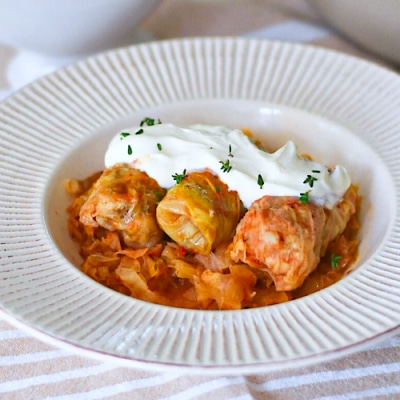Sarmale (Romanian Cabbage Rolls)

The Romanian word “sarma” is borrowed from the Turkish language – sarmak, where it means “to wrap”. Sarmale is just that – cabbage (in this case, sour cabbage) wrapped around minced pork, rice and sometimes vegetables. In some regions, vine leaves are used instead of cabbage.
Sarmale is a favorite dish in many central and eastern European households, with recipes passed down from generation to generation, and Romania doesn’t make an exception. You can easily call sarmale Romania’s most popular food, a favorite dish to celebrate both the Christmas and Easter holidays.
It is safe to to say that the traditional sarmale recipe always includes some kind of ground meat (typically a combination of pork and beef) and also rice, as well as traditional sour cabbage leaves. As it is a rather heavy food, it is most commonly prepared in winter, and served on polenta, sometimes with potatoes or bread, “cooled” with yogurt, cream, dill and horseradish.
While the traditional sarmale recipe is made with ground meat, Romanians also make a vegan version (sarmale de post) during lent. In the vegan version, ground meat is usually replaced with mushrooms.

Sarmale (Romanian Cabbage Rolls)
Ingredients
- 500 g ground pork or a mix of pork and beef
- 50 g rice
- 1 teaspoon salt
- ½ teaspoon black pepper
- ½ teaspoon dried thyme
- 2 heads of pickled cabbage select the best leaves for rolling
- 250 ml tomato puree
- fresh thyme sprigs
- 2-3 dried bay leaves
- a few whole peppercorns
- a few pieces of smoked pork hock or smoked bacon
For serving:
- sour cream
- fresh thyme
Instructions
- In a bowl, mix the ground meat with rice and spices.
- Carefully separate the cabbage leaves, setting aside the whole ones suitable for rolling.
- Chop the broken or unusable cabbage leaves and set them aside to layer at the bottom of the pot and over the stuffed rolls.
- In a cast-iron pot, layer 125 ml (1/2 cup) of tomato puree, bay leaves, fresh thyme sprigs, and some chopped cabbage at the bottom.
- Place a spoonful of the meat mixture in the center of a cabbage leaf, fold two opposite sides, then roll it tightly. Repeat until you have used all the filling (makes around 25-30 rolls, depending on their size).
- Arrange the stuffed cabbage rolls in the pot, layering them in a circular pattern on two levels, leaving space in the center for the smoked pork hock.
- Cut the smoked pork hock into pieces and place them in the middle of the rolls.
- Top with chopped cabbage, pour over the remaining tomato puree, sprinkle in the peppercorns and a few fresh thyme leaves, then add enough water to fully submerge the rolls.
- Cover the pot with a lid and bake in a preheated oven at 200°C/390°F for 2 hours. Check occasionally to make sure the liquid doesn’t evaporate completely—though usually, no extra water is needed.
- Serve the hot stuffed cabbage rolls with sour cream and fresh thyme leaves. They are absolutely delicious!
Notes


Related: Mushroom-stuffed Cabbage Rolls
Related: Romanian Lamb Soup with Sorrel
Related: Romanian Chicken Noodle Soup (Supă de Pui cu Tăieței)
Related: Ciorba de Perisoare (Romanian Meatball Soup)
Related: Ciorba Radauteana (Romanian Sour Chicken Soup)

